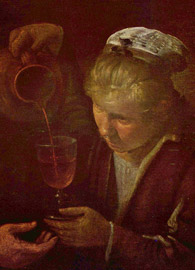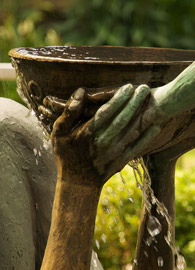John Week 3
Blazing Signs of the Times: Abundant Life, Controversy, and Confusion: John 2–4
Seattle Pacific University Assistant Professor of New Testament
Read this week’s Scripture: John 2–4
16:54
Key Prologue terms: sight/signs; glory; light/darkness; life; truth; testimony; children of God
Looking for Water and Signs

 Enlarge
Enlarge
On two different occasions my brother and I have had the privilege of hiking in Grand Teton National Park. There are several important items that hikers need for the trail: good shoes, a trail map, food, and water. Also, it’s important to be able to see the blazes, or markers. These blazes reassure hikers that they are still on the trail and haven’t wandered off the designated path.
On one memorable hike in the Tetons, we neglected to bring enough water. On another, we had trouble finding the blazes along the trail that were the signs we needed to ensure we would get to our destination rather than be found by curious bears. While the Gospel of John does not describe hiking adventures, chapters 2–4 note the importance both of having water and of seeing carefully placed signs that lead us on the right path. John describes some of Jesus’ actions as “signs” (2:11; cf. 4:54) because they point to Jesus’ death, resurrection, and therefore to God’s glory. These signs are the trail blazes in John’s gospel that continue to point the way toward the cross and the empty tomb.
It’s a Party, and the Water is Waiting
In John 1 we saw John the Baptist testifying to Jesus’ identity, and we met Jesus as some followers gathered around him. One of these disciples was Nathanael. Jesus now arrives [Author’s Note 1] in Nathanael’s hometown of Cana (21:2). Here, as the first action of his public ministry in John’s gospel, Jesus turns water into wine (2:7–9). This may seem like a rather unusual choice for Jesus’ first sign in the gospel. However, in this story of celebration, the Fourth gospel makes some key points that are central to describing the identity of Jesus in the rest of the narrative. This story introduces themes of new life, time, and signs.
One of the most important reasons that John 2 describes Jesus’ actions at a wedding is that weddings symbolize, in several ways, how Jesus has brought new and abundant life to the world (see 10:10). A wedding should be marked by joy, and it establishes a new era for the married couple and their families, now joined together. Jesus’ ministry, too, is marked by joy and is bringing about a new era, a new time that is now here (see 4:23), when one who is God is in our midst, joining us together with him (1:14; cf. 4:25). Furthermore, the abundance of wine that Jesus creates (approximately 120 gallons!) is incredibly large, far beyond what even an extravagant weeklong wedding would require. It may echo a future prophecy of a different marriage, the wedding supper of the Lamb, described in Revelation 19:7–9. Essentially Jesus’ actions in bringing about new life through an abundance of wine for a wedding celebration mark his ministry as the beginning of a new age.
This new age begins with a particular emphasis on time. When Jesus’ mother tells him that the party has run out of wine, Jesus replies, “Woman, what concern is that to you and to me? My hour has not yet come” (2:4). [Author’s Note 2] This hour, later in the gospel, is the hour of Jesus’ glorification (12:23), meaning his death, resurrection, and exaltation, and it only comes when Jesus is ready for it (7:30; 8:20; 12:27; 13:1; 17:1). Essentially Jesus turns water into wine at this wedding because it reveals God’s fundamental action in this gospel: God brings life out of death, most clearly in Jesus’ death and resurrection but also in small ways. Wine from water is a sign that God’s life-giving presence and power (also known as “glory,” see 2:11; 1:14; Exodus 24:15–18; 34:29–35) is here at this wedding in Cana.
Jesus’ actions reveal that God’s presence works illogically (2:10) and somewhat mysteriously (2:9). In fact, the steward’s lack of knowledge about the wine’s origin parallels the stated ignorance about Jesus’ own origin in the gospel (6:37–44). Much of John, including these passages, narrates the blind ignorance or misunderstanding of those around Jesus. Nevertheless, this miracle serves as a sign for those with eyes to see.
From the Party to the Cleanup
The next scene narrates a post-party cleanup at the Temple in Jerusalem (2:13–22). First, it’s important to note a few differences between John’s account and the accounts in Matthew, Mark, and Luke. In the other three gospels Jesus’ actions in the Temple are the prelude to his arrest at the conclusion of the gospels. Furthermore, the other gospels only mention Jesus arriving at Jerusalem once, at one Passover. The Gospel of John narrates three different Passovers [Author’s Note 3] and places the account of Jesus cleansing the Temple at the beginning of Jesus’ ministry. These differences highlight central themes of this passage in John’s gospel. Here, the Temple “cleansing” is more complete. The verbal conflict with authorities over interpretations of Scripture and Jesus’ words has begun, and the evangelist highlights the disciples’ need for further interpretations of these events.
When compared with the other gospels’ accounts, one of the striking things about John’s narrative is that he describes a two-part cleansing. He claims Jesus drove out the moneylenders, or those that could perpetuate a corrupt system, as the other gospels describe. These moneylenders could use extortion to take advantage of the impoverished pilgrims who came to change their Roman money into Temple money. However, John also mentions that Jesus drives out the animals for sacrifices, specifically the sheep and the cattle (presumably releasing the doves, though it does not say; 2:14–15). In other words, Jesus is implicitly claiming that the sacrificial system itself needs reformation — or perhaps abandonment. This is a far more substantial and radical claim.
John highlights the controversies between Jesus and the religious leaders, often called the Jews (2:18). [Author’s Note 4] As others do in the gospel, these leaders misunderstand Jesus’ “sign,” which is given in words: “Destroy this temple, and in three days I will raise it up” (2:19). These leaders interpret Jesus’ words literally, while readers of the gospel know that they are meant to be an allegory (2:20–21). By creating this allegory Jesus points readers to the radical reorientation of this gospel. In declaring himself as the ladder connecting heaven and earth (1:51) Jesus is also declaring himself to be the Temple, that is, the place where heaven and earth meet. Therefore, destroying the Temple is equivalent to destroying Jesus’ body, and vice versa. [Author’s Note 5]
At this point John’s gospel refers to the interpretive work necessary for the disciples to understand Jesus’ ministry rightly in light of the resurrection. The reason that many aspects of Jesus’ identity and ministry seem so clear to modern readers is precisely because of this spiritual remembering. This remembering is not simply recalling an event accurately; instead, it requires the work of the Spirit (14:26) to understand how to interpret a past event in light of the present work of God. This is how John illustrates the Church reading Scripture. Reading Scripture and recalling Jesus’ words should result in an increased faith (2:22) and obedience (cf. 15:1–17). Finally, the gospel’s comments about the challenge of accurate interpretation (2:21–22) remind readers of the difficulty in accurately interpreting Jesus’ signs, whether in actions (2:1–12) or words (2:19), both then and now (2:23–25).
A Nighttime Encounter
In this gospel, light and darkness are always opposed: light indicates the presence of God or salvation (see 1:4–5; 8:12), while darkness indicates God’s absence or judgment (3:19–21; 13:30). So when Nicodemus, a Pharisee [Author’s Note 6], comes to Jesus at night, the gospel’s readers already know how to interpret this signal. Nicodemus also comes to Jesus assuming that he and others know what Jesus’ signs mean: they mean that God is with Jesus (3:2). Jesus’ reply indicates that knowing that signs reveal God’s presence is not enough. Instead, with puns and wordplays, Jesus describes what is needed to “see,” “enter,” or “have” (3:3, 5, 15–16) eternal life.
Essentially, through the use of these wordplays [Author’s Note 7], Jesus declares the necessity of the Holy Spirit, who enables one to see rightly the eternal life that Jesus offers. This echoes the prologue’s statement, namely that to all who believe Jesus, he “gave power to become children of God” (1:12), and this power is the power of the Spirit.
Finally, Jesus describes his death in a new way in this passage. In the extension of his conversation with Nicodemus [Author’s Note 8], Jesus says that the Son of Man must “be lifted up” (3:14). While this image should immediately bring to mind Jesus’ crucifixion, as the cross is lifted up, the verb (ὑψόω, hypsoo) means both “lift up” and “exalt.” Again, as with the Temple and with Nicodemus, Jesus plays with the literal and symbolic meanings of words to get his point across. Here he indicates that he will indeed be exalted on the cross, and this exaltation will bring healing (see Numbers 21:8–9) and life for those who see it as God’s presence (John 3:15–16). [Author’s Note 9]
In order for Jesus to be “lifted up” or “exalted,” others must back away from the spotlight. One of those who must recede is John the Baptist (3:22–36). As he exits this gospel’s stage, he is clear that his primary role has been to testify to Jesus’ identity (3:28–30; repeated emphasis on testimony 3:31–36). As he does this, he again mentions a wedding, our starting context in John 2. This metaphor works on several levels. John functions as the best man at Jesus’ wedding: he is thrilled for Jesus, but he cannot steal the stage. Further, imagery of Jesus as the groom echoes imagery of God’s people (Israel, and then the church) as a bride (see Isaiah 62:5; Jeremiah 2:2; Hosea 1–2; Revelation 19:6–8; 21:9–10). Lastly, this second instance of wedding imagery sets the stage for a final echo in John 4.
A Noontime Conversation

 Enlarge
Enlarge
The next scene in the gospel describes Jesus’ journey from Judea, where he has been since cleansing the Temple (2:13–22), to Galilee. Jesus unexpectedly chooses to return to Galilee by going directly through Samaria (4:4). As this narrative indicates, relationships between Samaritans and Jews were not good, though both traced their roots back to the kings of Israel.
Jesus has just described how the Spirit — like the wind — blows where it will (3:8). This time, the Spirit “blows” Jesus (and the disciples) to a Samaritan woman at a well. In light of stories in the Old Testament like Isaac and Rebekah, Rachel and Jacob, and Moses and Zipporah, a well had significance beyond quenching thirst; it was where a man could encounter his future wife. We hear the overtones of marriage again in John 4 reflected in the astonishment of the disciples (4:27), but the narrative thwarts those expectations. Instead of talking marriage, Jesus and this woman talk theology! [Author’s Note 10]
When Jesus arrives at the well and meets the woman, he is thirsty and asks her for water (4:7). Jesus again speaks in metaphors (4:10–15; cf. 4:31–38). The phrase “living water” he uses (4:10) can mean either flowing water, as in a stream or a river, or the water of life. Jesus describes water that brings abundant life, and this abundant life is now available through him. He is not only a prophet (4:19), but is also the Messiah (4:25–26) and the Savior of the world (4:42). The Samaritans believe in Jesus first on the basis of the woman’s testimony (4:39), followed by their direct encounter with the one who brings abundant life (4:42).
Life out of Death
At the conclusion of John 4, the gospel mentions Cana again (4:46). This time Jesus is not at a wedding celebration but is met by a royal official who is afraid he is about to attend his son’s funeral. The main conversation between Jesus and the royal official is again about signs. Jesus proclaims to an ambiguous plural you that “unless you [all] see signs and wonders you [all] will not believe” (4:48). This is not directed at the royal official, but rather at others in the gospel who have been or will be focused on the signs that Jesus does (cf. 6:30).
In contrast, the royal official simply reasserts his first statement, asking Jesus to come to Capernaum, over twenty miles away. The official demonstrates belief before he sees a sign (4:50). This belief was secured (and expanded to include his whole household) once he returned home and found that Jesus’ word had indeed brought life out of death for his son (4:53; cf. 4:39–42).
The first sign in Chapter 2 and the last sign in Chapter 4 are singled out by the narrator, so John’s audience is to assume that they reveal God’s presence in particular ways. These signs focus on how Jesus brings abundant life, either symbolized by an excessive amount of wine at the Cana wedding or embodied by the restored life of a sick boy. Furthermore, this abundant life is available to all, whether Jew or Samaritan, unnamed family wedding guests, or a royal (likely Gentile) official. Finally, this abundant life is available to the world because God so loved it and gave Jesus up to death (3:16). Ultimately these signs all point to a God who brings life out of death, from a cross to an empty tomb.
Signs and Water
Back on the hiking trail my brother and I would take turns searching for blazes on particularly complicated trails. We were seeking signs that we were still on the right trail. Sometimes, either due to poor trail maintenance or to our distracted vision, we would miss a blaze or two and end up lost. Then we would follow a trail on faith, believing that we would see a blaze before we actually saw one. Sometimes signs, like blazes, precede faith; sometimes they follow it, whether on the trail or in the fourth gospel.
However, in the Grand Tetons we learned quickly the importance of water. Without water, it would not matter which trail we followed. In this section of the gospel the water that Jesus offers is another metaphor for the abundant life that he grants. This abundant life lavishly sustains and brings joy to all who experience it. Water transforms signs and belief into a richly nourishing life.
Questions for Further Reflection
- Choose one of the signs discussed in this Lectio. Describe each character’s reaction to the sign. Are they on the right trail or not?
- Look at the characters in the signs in these chapters and their responses to Jesus’ presence. Identify characters who show evidence of abundant life, controversy, or confusion. With which category of character do you most closely identify?
- Think about the signs in your own life. What trail are you following? Where will this trail lead?
<<Previous Lectio Back to John Next Lectio>>

This work is licensed under a Creative Commons License.





I am thoroughly enjoying this Bible Study! I especially like all of the author’s notes throughout the lesson. The notes give background information into the way of life when Jesus was here on earth and the meaning of the Greek words used. Thank you, Dr. Sweat, for a great study.